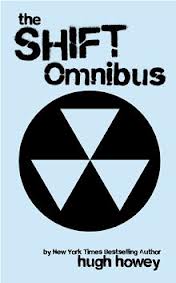 Shift goes back to the time just before the apocalypse, to the story of one Congressman Donald Keene, who is asked by the leading power-broker of his time, Senator Thurman, to undergo a strange architectural project near Atlanta. His story, and the story of the horrific things he learns while on that project, are intertwined with the story of Troy, many years later, awakened from cryogenic sleep for his shift as leader of Silo 1, the silo that secretly runs all the others.
Shift goes back to the time just before the apocalypse, to the story of one Congressman Donald Keene, who is asked by the leading power-broker of his time, Senator Thurman, to undergo a strange architectural project near Atlanta. His story, and the story of the horrific things he learns while on that project, are intertwined with the story of Troy, many years later, awakened from cryogenic sleep for his shift as leader of Silo 1, the silo that secretly runs all the others.
In other silos, men and women live as normally as possible- getting married, having children, dying – but in Silo 1, all the women and children are kept in deep sleep, while the men are awakened on and off for six month shifts. The men are given drugs to ensure that they don’t remember their past lives, prior to the great catastrophe, but Troy proves resistant, and what he remembers may drive him crazy or may put him in a position to save thousands upon thousands of lives.
We are also given the tales of Mission, a young porter in Silo 18, and his participation in an uprising that takes place before the events in Wool, and the backstory for Jimmy Parker, survivor of an uprising in Silo 17 and a major character in Wool.
These stories should be read after those in Wool, as they intertwine with those stories and fill in many of their gaps and loose ends. In these, the story of how and why the apocalypse happened, how the silos were planned and structured, and why, is told from the perspective of those responsible, and the result is a disturbing tale of human moral dilemmas in an impossible situation.
Shift is well-written and thought-provoking, with fully-developed, real, human characters with whom the reader can identify and sympathize. The story is unveiled bit by bit, revelation by chilling revelation, leading the reader along with the characters and events until even the most savage and horrifying decisions become scarily plausible, even rational. The moral choices before the characters are terrible, and the author lays them before us starkly, without candy-coating or whitewashing, leading us to imagine what we would have or could have done in each of the characters’ places. (And on a personal note, I would like to thank the author for assuring me that Kramerbooks in Dupont Circle will survive until at least 2049.)
There are small typos in one or two places, but nothing terribly serious (for example, when Silo Twelve’s fear index is described as “a little high, but not too low”).
This is a marvelous book, a fitting companion to the equally excellent Wool, and it deserves a look from anyone who enjoys a thought-provoking and mentally-stimulating read.
Reviewed by Catherine Langrehr for IndieReader

